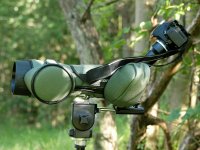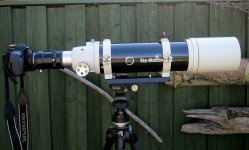Hi,
I do not have a very extensive background in birding, being limited primarily to my back garden and the local nature parks. I have taken a few shots with my Canon 40D and 100-400 EF lens (purchased particularly for nature) which were not too bad, but the reach of the lens was often inadequate. Wanting to extend this, I tried adding a proper Canon EF 2x converter, but the results were poor as it was difficult to focus properly, the images were dark and far too soft if not completely out of focus most of the time. The other disadvantage was that the setup was rather heavy.
A friend of mine who is an avid birder mentioned digiscoping so I have been looking into what this is all about. I already have a Lumix LX5 compact camera which I understand is suitable for this but am not wondering what scope to buy. Since I also come from an astornomy background, I initially looked at the Celestron Regal and Ultima scopes which also take astronomy eyepieces and would make the scope 'dual purpose' - birding and wide field astronomy. My friend however suggested a secondhand Kowa.
Of course, I realize that the requirements for a daytime terrestrial scope are very different to a nighttime celestial one. I also note from some comments on this forum that 80mm seems to be the minimum recommended aperature for digiscoping. So I guess my question is whether it is viable to use a dual purpose scope such as the Celestron? Will a Kowa be better for digiscoping? Will it take 1.25in astro eyepieces - do spotting scopes in general?
We already have an astro scope so good quality digiscoping rather than astro work would be my primary concern in this case. Are many of the budget scopes (£90-200) suitable for this or do I need to spend considerably more on a APO/ED type scope to get decent results?
Note, I can't really afford a Swaro or Leica, nor am I seriously enough into birding yet to justify such an expense. I would prefer to start with something at the budget end that is viable for digiscoping and would give me encouraging rather than frustrating results. I might consider something something in the £200-300 as a long term investment. I have a Slik Diamond 88 tripod which I am hoping will suffice for this purpose?
I would also need advice on how to connect the camera (LX5 to the scope).
As you can see, have many questions to any comments will be appreciated.
I do not have a very extensive background in birding, being limited primarily to my back garden and the local nature parks. I have taken a few shots with my Canon 40D and 100-400 EF lens (purchased particularly for nature) which were not too bad, but the reach of the lens was often inadequate. Wanting to extend this, I tried adding a proper Canon EF 2x converter, but the results were poor as it was difficult to focus properly, the images were dark and far too soft if not completely out of focus most of the time. The other disadvantage was that the setup was rather heavy.
A friend of mine who is an avid birder mentioned digiscoping so I have been looking into what this is all about. I already have a Lumix LX5 compact camera which I understand is suitable for this but am not wondering what scope to buy. Since I also come from an astornomy background, I initially looked at the Celestron Regal and Ultima scopes which also take astronomy eyepieces and would make the scope 'dual purpose' - birding and wide field astronomy. My friend however suggested a secondhand Kowa.
Of course, I realize that the requirements for a daytime terrestrial scope are very different to a nighttime celestial one. I also note from some comments on this forum that 80mm seems to be the minimum recommended aperature for digiscoping. So I guess my question is whether it is viable to use a dual purpose scope such as the Celestron? Will a Kowa be better for digiscoping? Will it take 1.25in astro eyepieces - do spotting scopes in general?
We already have an astro scope so good quality digiscoping rather than astro work would be my primary concern in this case. Are many of the budget scopes (£90-200) suitable for this or do I need to spend considerably more on a APO/ED type scope to get decent results?
Note, I can't really afford a Swaro or Leica, nor am I seriously enough into birding yet to justify such an expense. I would prefer to start with something at the budget end that is viable for digiscoping and would give me encouraging rather than frustrating results. I might consider something something in the £200-300 as a long term investment. I have a Slik Diamond 88 tripod which I am hoping will suffice for this purpose?
I would also need advice on how to connect the camera (LX5 to the scope).
As you can see, have many questions to any comments will be appreciated.





